|
|
|||
|
(Back to Preceding Week; on to Next Week) |
|
IT'S NOT EASY BEIN' GREEN . . .
IN WINTER Kermit the Frog (below right)--one of the more astute philosophers of the 20th and 21st centuries--first came to fame on the Sesame Street TV show, where he crooned a melancholy tune that included the words "It's not easy bein' green."
All text & photos © Hilton Pond Center When folks talk about "evergreens," they're usually referring to plants such as pines and Eastern Red Cedars--i.e., non-deciduous needle-bearing trees that retain foliage year-round. These "softwoods"--so-called to distinguish them from leaf-dropping broad-leaved "hardwoods"--are prevalent in the woods surrounding Hilton Pond, but our early January stroll revealed a surprising number of non-coniferous plants still green despite cold weather. The first evergreen we encountered was a patch of Pipsissewa (above), growing beneath a tall leafless White Oak near the edge of Hilton Pond. This native wildflower's penchant for having year-round foliage is evident in its alternate name, Spotted Wintergreen. As one might suspect, "Pipsissewa" comes from a Native American language; in Cree it means "breaks into pieces," referring to the Indians'' habit of using it to treat gallstones. The scientific name, Chimaphila maculata, is descriptive of the plant's lifestyle, with the genus coming from the Greek words kheima "winter" and phileo "to love." This is indeed a winter-loving plant whose spiny and leathery two-inch leaves--highlighted in ghostly white--enhance our landscape throughout the year.
Right beside the Pipsissewa was another plant with spiny 1.5-inch evergreen leaves: A young American Holly, Ilex opaca (above). This native tree grows in the understory but still gathers enough sunlight to thrive in mixed woodlands from Massachusetts south to Florida and west to East Texas. Although we have several mature hollies at Hilton Pond Center, we've never seen berries on any of them. This may be because all our trees are males--female flowers are on separate trees--or perhaps resourceful robins and mockingbirds get to the fruit before it turns completely red and becomes obvious to our eyes. Being evergreen and long-lasting, holly leaves seem to be optimal hosts for some pathogens; diseases known to affect them include 14 species of leaf spot fungi, six black mildews, two powdery mildews, and one rust. The otherwise healthy green leaf in the photo above is affected by one of them. It's interesting that Ilex, the genus name for hollies, comes from a Latin word for the Holm Oak, Quercus ilex, an evergreen with "holly-like" leaves that grows in lands bordering the Mediterranean.
We continued down the trail as the afternoon sun dropped lower on the horizon and backlighted the next plant on our growing list of broad-leafed Hilton Pond evergreens. This specimen was another tree--a Southern Magnolia, Magnolia grandiflora (above)--whose ten-inch leaves were considerably longer than those of Pipsissewa or American Holly. In normal view magnolia leaves appear thick and dark green, but the sun's rays were strong enough to pass through the foliage, revealing the leaf's veins and a yelllow-green tint. Also noticeable were small brown specks--undoubtedly damage from insects or perhaps from fungi similar to those on the holly leaf. Even at its natural limit in northeastern North Carolina, Southern Magnolia holds its shiny green foliage all winter long. Incidentally, the name "magnolia" is in honor of Pierre Magnol (1638-1715), a French botanist who first described a classification system in which closely related plants are placed in the same "family."
Growing up the trunk of the 15-foot magnolia was yet another winter evergreen, this time a spindly twisted vine armored with nasty-looking thorns. The elongated heart-shape of the leaf, the straight (not curved) spines, and a green stem indicated this was one of the Greenbriers, Smilax spp. Of the 200-plus species of Greenbrier found worldwide, several are deciduous, but those at Hilton Pond Center are all "evergreen"--even though some may bear a few leaves that temporarily turn red in winter as green chlorophyll dies. The scientific name for Greenbrier comes from a Greek tragedy in which the mortal man Krocus dies and is turned into a flower despite his love for Smilax, a woodland nymph who herself perishes and becomes a thorny vine. (Don't you just love those old botanists who knew Latin and Greek, and don't you fervently hope today's students are still learning about the fascinating world of ancient mythology?)
The last broadleafed evergreen we encountered on our January walk was in a small meadow adjoining Hilton Pond. There, among the brown and withered flower heads of Goldenrod, was a four-foot sapling with shiny yellow-green three-inch leaves. In fading light we recognized the young tree as a Water Oak, Quercus nigra. Leaves in this species are highly variable in shape--as unique as human fingerprints--and field naturalists sometimes have to look twice or thrice before being sure they've correctly identified a Water Oak. The oaks are generally lumped into two groups--red oaks (including the Water Oak) and white oaks--and both groups have representatives that are evergreen. As might be expected, those that retain foliage all winter have thick, leathery leaves and--as noted in other broad-leafed evergreens above--often show damage from extended months of exposure to fungi, insects, and the elements. Although folks often think of winter woods as brown and dead, it's pretty obvious from just an hour-log jaunt there's plenty of greenery along the trail at Hilton Pond Center. We found numerous trees, vines, and wildflowers whose foliage was about as bright as during warm days of summer--and we haven't even mentioned the still-green mosses, ferns, and lichens we also encountered. We're not sure how much photosynthesis goes in the evergreen broad-leafed flora described above, but it certainly appears--to counter the words of Kermit the Frog--that all these plants find it "easy bein' green" even on the coldest winter days.
All text & photos © Hilton Pond Center IT'S NOT EASY BEIN' GREEN (As sung by Kermit the Frog; lyrics © Jim Henson ) It's not that easy being green; It's not easy being green But green's the color of Spring, When green is all there is to be
Comments or questions about this week's installment?
Thanks to the following fine folks for recent gifts in support of Hilton Pond Center for Piedmont Natural History and/or Operation RubyThroat: The Hummingbird Project. Your tax-deductible contributions allow us to continue writing, photographing, and sharing "This Week at Hilton Pond." (Please see Support if you'd like to make a gift of your own.)
IMPORTANT NOTE: If you ever shop on-line, you may be interested in becoming a member of iGive, through which nearly 700 on-line stores from Barnes & Noble to Lands' End will donate a percentage of your purchase price in support of Hilton Pond Center and Operation RubyThroat. For every new member who signs up and makes an on-line purchase iGive will donate an ADDITIONAL $5 to the Center. Please sign up by going to the iGive Web site; as of this week, 117 members have signed up to help Hilton Pond Center. It's a painless, important way for YOU to support our work in conservation, education, and research. "This Week at Hilton Pond" is written & photographed You may wish to consult our Index of all nature topics covered since February 2000. You can also use our on-line Hilton Pond Search Engine at the bottom of this page. For a free, non-fattening, on-line subscription to |
|
Make direct donations on-line through
Network for Good: |
|
|
LIKE TO SHOP ON-LINE?
Donate a portion of your purchase price from 700+ top on-line stores via iGive: |
|
|
Use your PayPal account
to make direct donations: |
|
| The highly coveted Operation RubyThroat T-shirt --four-color silk-screened--is made of top-quality 100% white cotton--highlights the Operation RubyThroat logo on the front and the project's Web address (www.rubythroat.org) across the back.
Now you can wear this unique shirt AND help support Operation RubyThroat: The Hummingbird Project and Hilton Pond Center. Be sure to let us know your mailing address and adult shirt size: Small (suitable for children), Medium, Large, X-Large, or XX-Large. These shirts don't shrink! Price ($21.50) includes U.S. shipping. A major gift of $1,000 gets you two Special Edition T-shirts with "Major Donor" on the sleeve. |
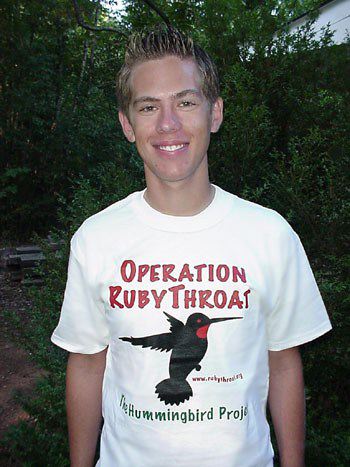
Need a Special Gift just in time for the Holidays? (Or maybe you'd like to make a tax-deductible donation during 2007) If so, why not use our new handy-dandy on-line Google Checkout below to place your secure credit card order or become a Major Donor today? |
|
|
|
|
SPECIES BANDED THIS WEEK: * = New species for 2008 WEEKLY BANDING TOTAL 5 species 24 individuals YEARLY BANDING TOTAL (2008) 6 species 48 individuals 27-YEAR BANDING GRAND TOTAL (since 28 June 1982) 124 species 50,215 individuals
|
OTHER NATURE NOTES OF INTEREST
--We banded an after-hatch-year female Rufous Hummingbird (above) at Columbus NC on 13 Jan at the home of Luanne and Buren Blankenship. This is the seventh time they have hosted a rufous in the past nine years. (An on-line write-up with photos will be posted later.)
|
|
|
|
(Back to Preceding Week; on to Next Week) Up to Top of Page Back to This Week at Hilton Pond Center Current Weather Conditions at Hilton Pond Center |
 You can also post questions for The Piedmont Naturalist |
Join the |
Search Engine for |
|
|
Puerto Rico Dating

 That phrase was a lament of social alienation; i.e., it's hard to be green when the world is full of brigher colors (and especially when juxtaposed against the shocking pinkness of Kermit's more-or-less beloved Miss Piggy). Eventually Kermit realizes his greenness is what makes him special, and the ballad ends by his glorifying greenness: "It's beautiful! And it's what I think I want to be." In reality, it's probably a LOT easier for a frog to be green than some other color--red, for example--in that bein' green helps an amphibian escape detection in its aquatic or riparian habitat. Likewise, bein' green is "easy" for plants; after all, with their emerald-colored chlorophyll, trees and shrubs and forbs are able to make their own food spring through autumn. But what about in winter? When days are short, the sun is at a bad angle, and ambient temperatures aren't very conducive to photosynthesis, how many plants are still bein' green? That was our question this week as we wandered the trails at Hilton Pond Center, looking for flora that still had leaves and winter greenness.
That phrase was a lament of social alienation; i.e., it's hard to be green when the world is full of brigher colors (and especially when juxtaposed against the shocking pinkness of Kermit's more-or-less beloved Miss Piggy). Eventually Kermit realizes his greenness is what makes him special, and the ballad ends by his glorifying greenness: "It's beautiful! And it's what I think I want to be." In reality, it's probably a LOT easier for a frog to be green than some other color--red, for example--in that bein' green helps an amphibian escape detection in its aquatic or riparian habitat. Likewise, bein' green is "easy" for plants; after all, with their emerald-colored chlorophyll, trees and shrubs and forbs are able to make their own food spring through autumn. But what about in winter? When days are short, the sun is at a bad angle, and ambient temperatures aren't very conducive to photosynthesis, how many plants are still bein' green? That was our question this week as we wandered the trails at Hilton Pond Center, looking for flora that still had leaves and winter greenness.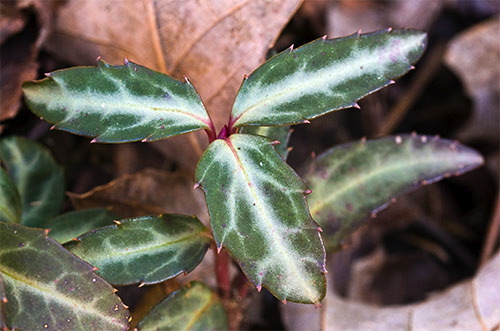
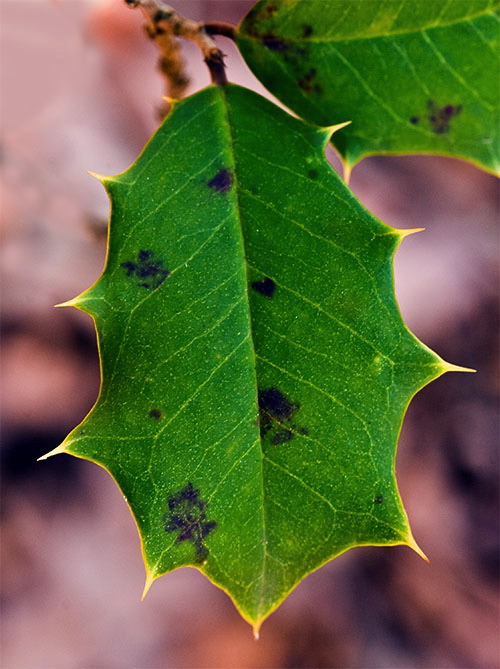
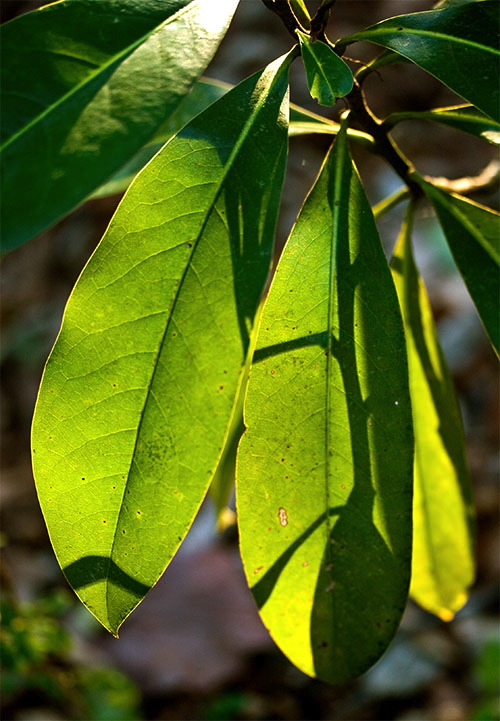
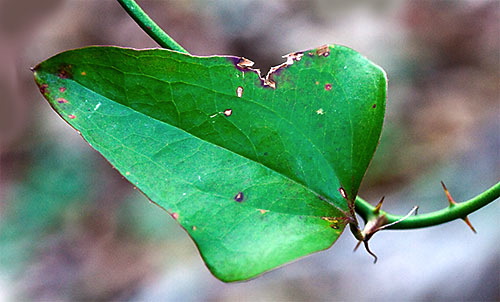
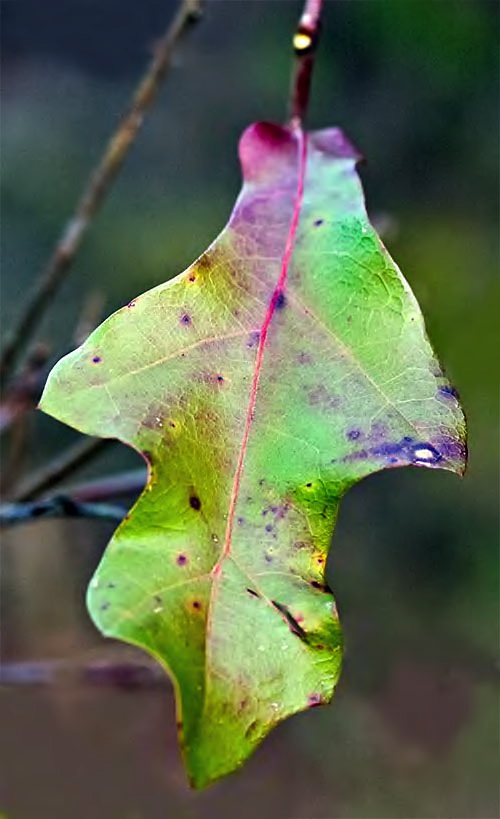


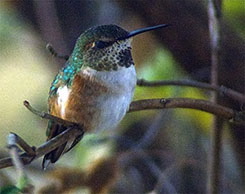
 Oct 15 to Mar 15:
Oct 15 to Mar 15: